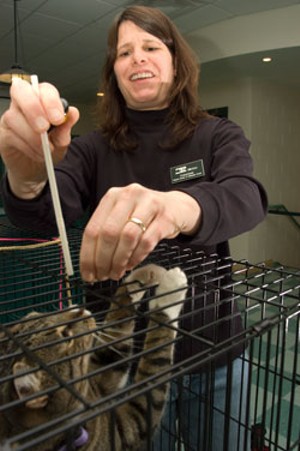Published March 11, 2009 at 5:52 a.m.
Winnie’s being ignored, and she doesn’t like it. The lithe tabby pokes a white paw through the bars of her cage, mewing plaintively. When that doesn’t elicit the desired reaction, she springs to a high perch, rises on her hind legs and offers her paw insistently.
Meanwhile, in the adjoining cage, a smaller tabby named Tiger is performing the same sequence of actions — in exchange for tuna treats. Winnie’s yowling draws the attention of Humane Society of Chittenden County volunteer Minton Clark, who’s prompting Tiger by tapping the bars with a straw. “Even though I’m not working with this cat,” she says, “she’s very engaged; she’s watching what’s going on and trying to do what Tiger’s being asked to do. They watch each other.”
All the news about local shelters overflowing with abandoned animals conjures images of unwanted cats crouching terrified in cages. But here in South Burlington, the felines seem more responsive and curious than shell-shocked. Some sleep on colorful donated beds. In another room, visible through glass, volunteers have arrived to give the cats some heavy petting. It’s all part of a strategy of “environmental enrichment,” says Clark.
Clark is moving from cage to cage, as she does once a week, practicing a simple training method that requires a cheap plastic clicking device, a drinking straw and a ready supply of chunk light tuna. Princess, a silky gray longhair with exemplary abilities, has just found a home. “I got here this morning, and all my clicker stars have been adopted!” Clark says.
That’s the whole point. Clark, 45, used to work at the HSCC and now serves on its board of directors. She explains that the petting, training and other attentions are all aimed at making the cats more sociable, and thus adoptable. An animal that stands up and volunteers a paw — even if it’s only in hopes of snagging a treat — is more likely to tug at human heartstrings than one that doesn’t engage.
Still … training cats? Everyone knows dogs are eager to please, but cats have a reputation for being above it all. (Or, some dog owners might say, not up to the mental challenge.) Solitary hunters with no notion of a pack leader, can they really be induced to do anything that’s not their own idea?
Why not? Clark started training her own cats after seeing a demonstration at a conference six or seven years ago, she says. She wanted to persuade them to use their scratching post instead of the furniture. She wound up teaching them to run through an obstacle course, “tell fortunes” and pound on the piano.
Three years ago, Clark brought her clicker-training methods to the HSCC after observing a similar program at the Upper Valley Humane Society. “I never thought it could work with shelter cats,” she recalls. “There’s too much going on; they’re too distracted. I was pretty amazed by how well the cats did at that shelter.”
Here, she says, training has proved an effective way to “overcome the shyness some of these cats might have. We’ve had a lot of success with some quasi-feral kittens.” And, surprisingly, the training sticks: “We had one cat that was adopted and then returned after five or six months,” Clark says. “The cat remembered everything. People don’t give cats enough credit. They can learn; they can retain things.”
Clicker training is a simple form of operant conditioning, aka behavior modification, that works on animal brains of all sizes. Clark demonstrates on Sparky, a black-and-white male whose owners abandoned him at a motel — another economic indicator, according to Clark. Unlike the show-offy Winnie, Sparky has never had a training session. Clark starts by giving the cat shreds of tuna while activating the distinctive tick-tick sound, so he begins to associate the two.
Next, she introduces a “target” through the bars — a straw that tempts Sparky to investigate with his nose, the standard feline way to process new info.
Probing with his nose earns Sparky some tuna. “When the cat does a desired action, you click and give them a treat, and the click reinforces the desired action,” says Clark, who has a low, feline-friendly voice and earnest brown eyes. “It builds a little bridge in their brain. It’s sort of an ‘if, then’ premise.”
While dogs shake hands, cats generally learn to “high five” a target. Sparky’s not there yet, though Clark rewards him when he desultorily raises a paw. “You’re being very laissez-faire about this,” she tells him, then voiceovers for Sparky: “‘I’ll just lie here on my pillow, and you can peel me a grape!’
“Sometimes with a cat, the only thing I’ll get it to do is just this,” Clark explains. “Which is great, because they’re sort of learning a foundation.” Extending paws is rewarded; so is “anything cute.”
Finally, Sparky is getting more interested in the straw that’s poking into his lair from above. He stretches up and reaches for it — a cell inmate’s version of the classic “sit pretty” move. “Perfect,” Clark croons. “Jackpot, there we go. Smart boy! First time I worked with this cat, and he’s 7 years old. You did such a good job, buddy!”
In one of the “cabins” down the hall — enclosures where cats get exercise — Clark works with a fluffy, white-nosed female named Frisky. After countless “high fives,” “down lows,” two-paw waves and sit pretties, Frisky is stuffed with tuna. But she refuses to sit on a shag-carpeted pedestal that was recently added to her space.
Cats are notoriously uncomfortable with change. “I have worked with scaredy cats, that have been really frightened, and gotten them sort of to come out of their shells,” Clark says. She recalls a litter of feral kittens that took six weeks to socialize; the whole staff pitched in. The first step is getting such an animal to accept human touch. By the age of 8 to 10 weeks, Clark says, ferals stay feral: “Sometimes they have to be a barn cat or whatever.” As for domestic cats that are simply shy, she says, “I try to think like a cat. Do you need a lot of toys? Do you need a box to hide in?” Once a cat overcomes its native cautiousness, training can be “a relief from the boredom of sitting in [the] cage.”
Clark has taught other volunteers to clicker-train, including the groups of 30-odd kids who attend Camp Paw Paw at the HSCC. She’s demoed her techniques in a video posted on YouTube. But the goal of the training isn’t to produce particularly accomplished felines — just animals that people want to adopt. It’s a bit like staging a house to make it more attractive to potential buyers. Just as the new owners don’t get to keep the decorations, “We don’t expect them to perform in their new homes,” Clark says.
A more stage-motherly ethos reigns in the well-appointed Tudor that Clark shares with her husband and three cats on Shelburne Street in Burlington. While she makes it abundantly clear that she has no desire to make her own pets into viral video stars, her pride is palpable when she talks about Randy, a 14-pound black-and-white longhair with almost preternaturally bright eyes. He’s “the smartest cat I’ve ever known,” she says.
Randy came to Clark after an early dog attack left him with a nub of an ear. He’s 11 now and living with Feline Immunodeficiency Virus, but that didn’t stop him from hamming it up.
Though he hasn’t been training for the past few months, Randy is ready to go today. He hops on a plastic container in the center of the kitchen, and Clark puts him through his paces. “High five! Down low! Sit pretty! Give me a wave!” (That’s scrubbing the air with both paws at once.) With her own cats, she doesn’t need the clicker, and offers the tuna so deftly that the incentive is barely noticeable to a human observer.
Next, Clark carries a stepladder into the dining room, saying to Randy, “You know what this is!” The ladder goes at the head of the table, which has been outfitted with a simple obstacle course made of candlesticks. “Up!” Clark commands.
“Weave!” The cat threads his way between the candles, eyes fixed on a tuna-bearing hand just out of reach. “Make some noise!” Randy springs from the table straight to the piano keyboard, where he uses his hefty paws to produce sounds Clark describes as “atonal improv jazz.”
In the living room, Randy “walks the catwalk” on a raised plank. Finally, back in the kitchen, he plays fortune teller, spinning a cardboard dial on the fridge to “answer” a question.
Clicker-training is strictly a method of positive reinforcement, and Clark says she never did manage to teach her cats not to sharpen their claws on woodwork and furniture. “My original goal was not met, so we moved on to loftier goals,” she says wryly. If she owned a barn, she adds, she’d build her cats a full-fledged agility course, as some trainers have done. Some have even coaxed their pets to play tunes on the piano. Sure, that sounds a bit silly — but training gives indoor cats something to do, and redirects energy they might otherwise devote to shredding the furniture, or each other.
So much for the myth of the Cool Cat. As we talk, a loud plink-plonking makes itself heard from the other room. Randy has returned to the piano keyboard for an unsolicited encore.
He’s determined to be noticed — just the sort of gregarious disposition that elicits a big human awwww, even if it’s partly about the tuna. For a shelter cat like Winnie, that eagerness to perform could mean the difference between a long stay in a cage and a short one.
2009 Animal Issue
This story was part of our 2009 Animal Issue. Click here for more animal stories.
Humane Society of Chittenden County, 862-0135, www.chittenden humane.org.
More By This Author
About the Artist

Matthew Thorsen
Bio:
Matthew Thorsen was a photographer for Seven Days 1995-2018. Read all about his life and work here.
Matthew Thorsen was a photographer for Seven Days 1995-2018. Read all about his life and work here.
Speaking of Animals
-

Q&A: A Clinic Has Cared for Old North End Pets for Almost 20 Years
Jan 31, 2024 -

Video: The Old North End Veterinary Clinic Has Kept Costs Low to Help Pets in Burlington for Almost 20 Years
Jan 25, 2024 -

Q&A: Merrymac Farm Sanctuary in Charlotte Provides a Forever Home for Neglected Animals
Dec 6, 2023 -

Video: Neglected Animals Find a Home With Era MacDonald at Merrymac Farm Sanctuary in Charlotte
Nov 30, 2023 -

Response Teams Provide Shelter for Pets of Evacuated Vermonters
Jul 16, 2023 - More »
Comments
Comments are closed.
From 2014-2020, Seven Days allowed readers to comment on all stories posted on our website. While we've appreciated the suggestions and insights, right now Seven Days is prioritizing our core mission — producing high-quality, responsible local journalism — over moderating online debates between readers.
To criticize, correct or praise our reporting, please send us a letter to the editor or send us a tip. We’ll check it out and report the results.
Online comments may return when we have better tech tools for managing them. Thanks for reading.












































